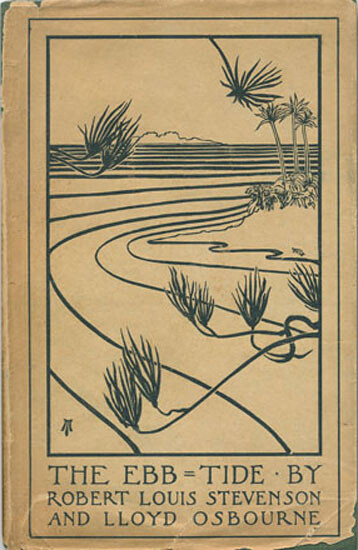When R.L. Stevenson undertook his first transatlantic voyage at the age of 25, journeying to reunite with his future wife in California, he wrote the essay “The Amateur Emigrant.” This writing became the first chapter of his collected works, Essays of Travel, published in 1905. On board the Devonia from London to New York in August of 1879, he opens with scenes from “The Second Cabin”:
A few Scandinavians, who had already grown acquainted on the North Sea, were friendly and voluble over their long pipes; but among English speakers distance and suspicion reigned supreme. The sun was soon overclouded, the wind freshened and grew sharp as we continued to descend the widening estuary; and with the falling temperature the gloom among the passengers increased.1
In this account by Stevenson, and also more famously in the opening passages of Joseph Conrad’s Heart of Darkness, we are made to bear witness to the beginning of a journey, and to immediately access a plot of characters that are compatriots in making a specific voyage. While they are initially sketched with their codes of national belonging and social standing (the Lawyer, the Accountant, the Director, a fine young Irishman), they soon develop from a descriptive assemblage of exaggerated personal traits into a collective chorus brought together by the bond of the sea, by the mesh of travel memories and cultural relations formed through a shared sea-route.
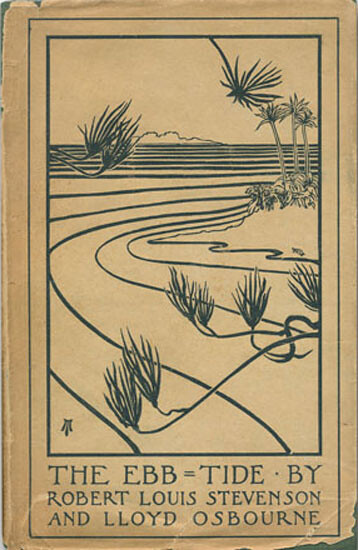

These ships become a sensing ground—a space of exposed bodies, ideologies, infrastructural and social productions. From their shared departure point of the Thames, the Devonia and The Nellie both lift their anchor and therein also depart from “European gloom.” While the Nellie sets course towards the New World of California, Conrad’s steamboat glides into the final leg of its journey where it is deeper and quieter. There is a sense of alienation and incomprehension in the unknowable quality of his environ—the entrance into an unearthly earth. He then states, “We were cut off from the comprehension of our surroundings. We glided past like phantoms, wondering and secretly appalled, as sane men would be before an enthusiastic outbreak in a madhouse.”2
The Mangrove’s Spectral Subject
The mangrove is itself just such a place where the earth seems unearthly. It is here that human traces cannot survive as a lasting form, for this tropical coastal ecology is a site of continual refiguration: neither sea nor land, neither river nor sea, bearing neither salty nor fresh water, in neither daylight nor darkness.
Air is the weight of water—and the leg that ventures into a mangrove swamp is asking to be eaten. If it isn’t snapped up by saltwater crocodiles, a tiger, or tropical insects, it will at the very least partially disappear in the dense mud between protruding roots. Memory fails in the mangrove, just as the marking of claims becomes impossible.
The mangrove has been prone to confused definitions, since it is a grouping of over eighty specialized plant species that survive as “botanical amphibians,” but is also a complex coastal ecosystem in itself. With these hybrid conditions of “belonging,” the mangrove lends itself to helping us think through the present-day schematic of Euro-American crises amid larger constellations of political insurrections and migratory movements. Its polymorphous personality as a sediment-carrier, land-builder, defender of numerous life forms, and also an inadvertent protector of pirates renders the mangrove a fascinating study in the biopolitics of selfhood.
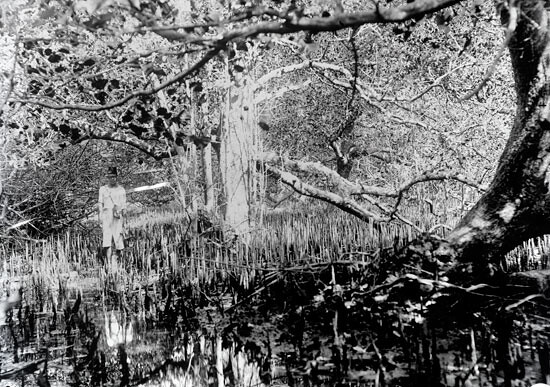

Made in the 1920s, the image of an unknown subject amidst mangrove vegetation in northwest Bali begins to signify the spectral nature of the mangrove environment, its impassable yet fecund qualities. While the photographer remains anonymous, it seems a relic “between” colonial fantasy and social documentary. The unspecified relation linking the photographer and the doubled subject of the figure with(in) ground gives vantage to the interval maintained in colonial administration and its conflated imaginary of native and nature. 3 It is an image depicting proximity that nonetheless institutes a barrier of distance.
However, in capturing the figure’s reflection, the image of it produces a double location: first enmeshed in the dappled shade and light of the background, and then spectrally as an upside-down figure formed by the water surface. Its duplication unsettles the camera’s emplacement of the figure as part of the landscape, extending a counter-image produced by the watery landscape. The pictorial organization of the photograph signifies, then, an inverted self—the upside-down nature of the mangrove root as a sensing ground for all that lies “above” the surface.
Of Inversion(s) and Extra-territoriality
Next to the human form, the mangrove appears as a field of suspension, a zone of impasse to usual technologies of passage. Unlike the ease of a ship moving through an estuary, the mangrove is impossible because it is impassable. The English explorer and natural historian William Dampier (1651–1715), the first person to circumnavigate the world three times, noted with frustration regarding the Red Mangrove of the West Indies:
It always grows out of many roots about the bigness of a man’s ankle, some bigger, some less … Where this sort of tree grows it is impossible to march by reason of these stakes, which grow so mixed one among another that I have, when forced to go through them, gone half a mile and never set my foot on the ground, stepping from root to root.4
The mangrove is, hence, a landscape demanding extra-ordinary measures. Its porous body, which renders it a fluctuating life determined by tidal cycles, provides it also with the quality of extra-territoriality. In the descriptions of nineteenth-century botanists and travelers, these tropical and subtropical mangrove regions appear as otherworldly places, strangely framed both as wastelands and as zones invested with extra-natural life force. Both types of description indicate a situation of exception—on the one hand, the image of pestilence, of the malarial mosquito; and on the other, the fable of a land so rich that oysters grow on trees.5
This image of an inverted self has its echo in the classic tarot card of “The Hanged Man.” This tarot archetype represents the suspended self, signaling the condition of being “withheld,” of being forced to take life as it comes. It is a card for introspection and “surrender” as modes of emotional release.
In sympathy, the mangrove may be read as a symbolic protagonist of the self, performing as a porous satellite that grasps signals from its environs by locating its roots upwards rather than burrowing underground to claim an authentic history, bound by complexes of majoritarianism. It is an unsettled self that simultaneously produces “subject” and “place” through sensible readings of surrounding life and politics.
The mangrove’s manner of suspension is also one of respiration, as it experiences rhythmic and daily tidal inundation. The adaptive stilt-roots common to the rhizophora, or “true mangroves,” partially raise the tree body, again expanding its exposed surface. As a sensory mechanism, it is one that remains “anchored” to location, and yet perpetually undertakes the task of absorbing its “surround.” It is this intricate dynamics of exposure that renders the mangrove a critical motif of affective cartography during times of hyper-mobility.
Bringing Deleuzian analogies above ground, the germination of the rhizophora occurs also as an airborne process, its seeds dropping as root-bearing organs—breathing, rolling, circling in the air. Hence, not determined by the subterranean, this inverted form indicates an alternate imagery to tropes of authenticity that fix rights and rightful territorial identity through downward-tending rootedness—as a contraction of “belonging” to the narrow column of heredity.
In times of heavy traffic, where bodies are pressurized into strands of belonging turning towards paranoid structures and self-insulation, the aerial root may permit a gasp of air.
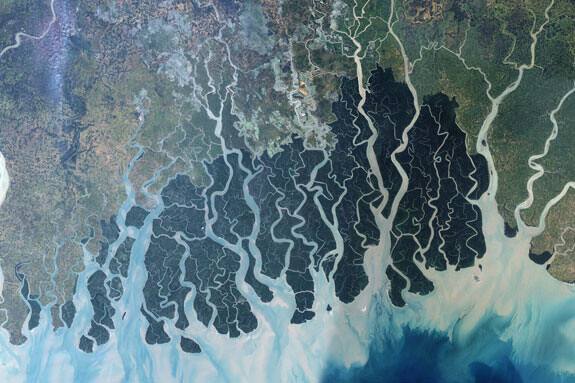

A Mangle of Names
The mangrove also traces a language cartography, setting sail through the routes of travel and the histories of encounter to which mangrove-naming bears witness. The hybrid terms that define mangroves in different linguistic cultures become conveyors of sociopolitical contact between civilizations and coastal ecologies. For instance, the combination of the old Malay word “mangi mangi” and the Arabic word “el grum” refers to the Avicennia genus of mangrove tree, which is a favorite attraction for fireflies. Or consider the juxtaposition of the Portuguese “mangle” with the English word “grove,” potentially linking the mangrove to the sacred grove.
However, the mangrove’s intense bed of foliage, punctuated with prop and stilt roots, remains antithetical to the manicured and decisively cultivated grove. It may therefore be more productive to reflect on the mangrove’s word origins not merely through land, but as linkages with a specific kind of tree and tide.
The Sundarbans covers an area of 10,000 square kilometers of intertidal zones between parts of southwestern Bangladesh and the state of West Bengal in India. The largest mangrove forest in the world, its name bears the combined genesis of a beautiful “sea forest” and of the Sundari tree, the Heritiera fomes species of mangrove, which grows across these wetlands in abundance.
The novelist Amitav Ghosh writes in The Hungry Tide (2005) of another traditional naming of the region:
In the record books of the Mughal emperors this region is named not in reference to a tree but to a tide—bhati. And to the inhabitants of the islands this land is known as bhatir desh—the tide country—except that bhati is not just the “tide” but one tide in particular, the ebb tide: it is only in falling that that water gives birth to a forest. To look upon this strange parturition, midwived by the moon, is to know why the name “tide country” is not just right but necessary.6
As a landscape, the Sundarbans is marked by unfixity, since its intertidal nature places it between appearance and disappearance—with islands being submerged overnight. It is ironic that while the aerial root systems of mangroves are highly valued as fortifications against the onslaught of angry tidal waves (as experienced during the tsunami of 2004) their porous quality does not allow for clear border-making. In reading this satellite image of the Sundarbans, produced by what is said to be “the most stable, best characterized Earth observation instrument ever placed in orbit,” we are met with the trembling instability of borders. The water channels eat into the land as gnarled roots of mangrove, uncontainable on ground and from an aerial view—here the coastline becomes indiscernible as a single entity.
The legal vexations of such amphibious and obtuse terrain become pronounced in sea-rights cases, wherein boarder-making becomes the necessity of tenure. Forming rulings over such zones lays legality prone to paradox. In the Blue Mud Bay case, heard by the High Court of Australia in 2008, a legal body was called upon to make a determination regarding the shifting geography of a mangrove coastal region. In the final ruling the aboriginal Yolgnu claimants were successful, with the court ruling that the column of tidal water lying above land should be regarded no differently from the land itself. Thus the court’s attempt to encompass Dholupuyngu cosmology and “aqueography” occasioned a legal magic transforming water flow into the fixity of “land.”7
The case has its echo in an earlier “land-mark” Yolgnu claim of 1973, the first native title case to be heard in Australian courts. In that instance, it was determined that the doctrine of terra nullius would be upheld, the basis upon which Australian nationhood is legally constituted through the disavowal of “prior occupation.” The regime of authentification that followed—necessitated in the making of exceptions to this doctrine of legalized dwelling—marked belonging as a status granted through mere recognition, mere naming in “title,” rather than inscribed in ongoing self-making and place-making processes.
In the intertidal and interpenetrating zone of the mangrove, the border between land and sea becomes a choreography of re-crossings. The mangrove line is, hence, one of sedimentary reclamation rather than clear political divisions of terra firma. In mangrove zones, human determinations become ghosts. The inability to form a mark is registered as a problem also of historicity.
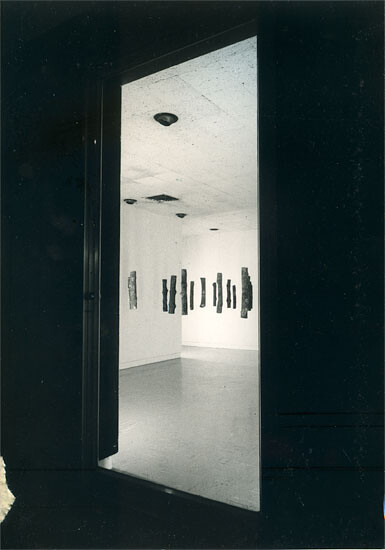

Regarding Place
Drawing figures, is figured.
Drawing pulls, pushes, tugs, drags.
Drawing is friction, gravity.
Earth draws, is drawn, draws maps.
Sun draws, draws shadows, photos.
Moon draws tides.—from Roberto Chabet’s exhibition Lines on Drawing (1999)
The artist’s shadow falls upon a patch of mangrove-dwelling mudflats. As Roberto Chabet photographs this ecology of aerial roots, there is a simultaneous charge of self-inscription and of capturing a “nearby.” At once, through proximity and a shadow of impermanence, this photograph becomes a conceptual process-note in which the mangrove emerges as coauthoring an indexical self. It is a figure of locationality and an agent of absorption, such that the principle of locating remains immersive.
The material form of the Bakawan, a local mangrove tree in the Philippines, has been a focal point across modalities of Chabet’s artistic production. Knowing the root became an inexhaustible journey of constant figurations, through installation, through drawing, through photography, through living close to tidal riverbanks, and through the common market sale of Bakawan segments for firewood. By turns this is knowing also as commodity, as the aesthetic, and as the “natural.”
Chabet’s first Bakawan exhibition took place in 1974, two years into the period of martial law proclaimed by President Ferdinand Marcos. It was held at the Cultural Centre of the Philippines, a heightened locus within the cultural politics of the Marcos regime. The installation presented a grid of fifty-six mangrove segments suspended amidst the representational void of a white-walled gallery setting. This scenography of “looking” was heightened by being viewable only through a glass door, its handle removed, both sealing the room and the symmetry of the setting. As poet and critic Joy Dayrit remarked, this suspended installation thus insists upon being viewed frontally, and yet it portrays the accentuated violence of the vertical—the mangrove as a barricade, as a territorialization after all.8
Throughout 1974, mangroves were the center of Chabet’s attention. He made a series of forty-eight watercolor and pencil drawings of Bakawan. The series was enfolded within the daily act of drawing and re-drawing “10,000 Things,” which subtends both Chabet’s work and his self-conception as an artist. These drawings often proceed in serial by tracing over a previous drawing, in a movement of both reproduction and annihilation, recurrent yet without producing a rehearsal of the same. The pictures do not accumulate to form a monumental image, nor is their memory of a monumental time. Through this ongoing act of self-exposure in observation and of self-application in drawing, Chabet produces not repetition but a kind of vivid co-presence enacted within a durative present.9
In his notes towards Regarding Place, No Place, Chabet outlines the multiple operations of “regarding”—of looking and seeing, of consideration and attention, of respect and esteem. The act of “regarding place,” then, is an act of making place through self-emplacement. The Bakawan works may perhaps also be seen as exercises in self-cartography amidst the estranged condition of martial law and parochial nationalism. Yet they also “act” beyond this realm of implicated belonging by structuring modes of a situatedness that is “between.” “Placement, location, is central in art,” Chabet writes, “This sense of place is the artist’s sense of self.”10
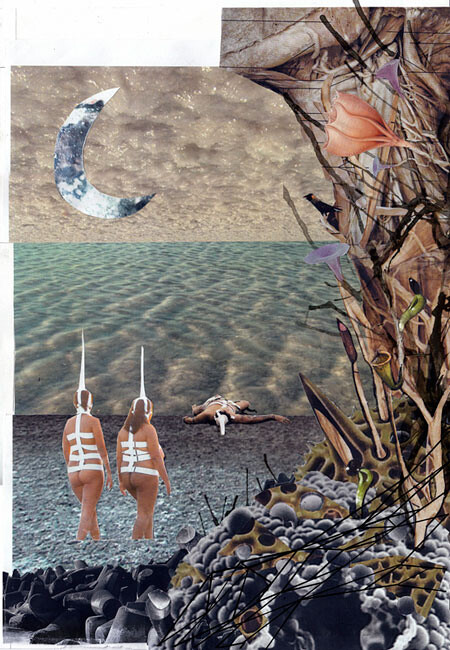

Unauthentic Belonging
To maintain an enduring receptivity while making journeys from known to unknown territories, one must have the capacity to risk states of exposure. Exposure to disease, exposure to friction between values, loss of control—and yet exposure as risk cleaves also to exposure as the opening into “real” transformation. In the histories of intercontinental commutorship, as well as in the excessive nature of present-day mobility, what ironically resurfaces is an attitude of isolation—a paradoxical in-transit state of quarantine. Hence, infrastructural intensifications have, to a certain extent, induced blockage in the capacity of sensation in body-land relations.
Quite unlike the estuary—a meeting between water forms—mangrove zones are catchment areas which invent potential models of entangled affectivity, enfolding fertile matter in detritus. They do so while performing exuberant cycles of re- and decomposition. However, in British colonial occupation and settlement, the problem of the mangrove was often solved with another: the problem of waste. Unfit for built structures or known forms of cultivation, the mangroves lining the banks of tidal rivers that permit access to settled towns were often zoned for landfill—as if areas that do not obey the demands of a territorial border should be punished, and should also become a field for acts of punishment.
In Between the Waves, Tejal Shah introduces us to improbable bodies that infiltrate the mangrove, its sediments, refuse, and excesses—becoming animal-plants and plants as animals. Suspended between states of dreaming and wakefulness, these ambiguous beings hold stimulatory appendages. And yet, in their sensing they remain beyond mutation and beyond forces of ownership. In the resistant flesh and dense fertility of the aerial root, we find the radical feedback of self-exposure.
The impossibility of the mangrove is designated as an externality, but in forming the contours of limitation it defines the cultural entity itself. It is a problem that binds. From this perspective, it is perhaps in its exceptional self-exposure that the aerial root is the root of an identity formation that is, by contrast, aware of the problems that it constitutes. Indeed, it is one that perhaps must know, from having been marked as unauthentic—as ill-fitted to the regimes under which identity is summoned. It is thus that the good feelings of “belonging” may give way to the bad faith of sovereign hypocrisies.
By producing the unauthentic, the possibility of inauthentification is instantiated. In the positive action of making belonging beyond prescribed bounds, the edifice of authority may be breeched. As Aimé Césaire wrote in his Cahier d’un retour au pays natal,
my negritude is neither tower nor cathedral
it takes root in the red flesh of the soil
it takes root in the ardent flesh of the sky
it breaks through opaque prostration with its upright patience.11
The root that heads also skyward, the quality of belonging that refigures narratives of place by figuring itself as upright, does not bind itself only to earthbound histories rendered as inert and received through descent. There is a reaching out into contact, a porosity. As Césaire writes in his Discourse on Colonialism, “for civilizations, exchange is oxygen.”12
Although written in 1879-1880, Robert Louis Stevenson’s The Amateur Emigrant from the Clyde to Sandy Hook was only posthumously published on account of the discomfort of Stevenson’s friends and family to its candid descriptions of dwelling amidst the lower-classes.
Joseph Conrad, Heart of Darkness, (original publisher: Blackwood’s Magazine, 1899).
Regarding the narrations by which native and nature became figuratively collapsed under a logic of cultivation in the British colonial context, see Rosalind Morris, “Imperial Pastoral: The Politics and Aesthetics of Translation in British Malaya,” Representations Vol. 99, No. 1 (2001): 159–194.
Cited in John Reader Jackson’s The Mangrove and Its Allies, published in 1900. At the time, Jackson was Curator of the Museum of the Kew Royal Botanical Gardens.
As portrayed in the accounts of one Dr. Hamilton, presented to the British Royal Pharmaceutical Society in 1846: “Its roots rise in the form of arches, above the muddy soil in which it grows, and affords attachment to myriads of small but delicious oysters, which are left bare during the efflux of the tide, giving rise to the popular fable of oysters growing on trees, which, with the exception of their not being fed by, but merely adhering to the tree, is literally true. These oysters make a most incomparable soup, of which I once partook at the house of an American merchant, at Cape Henri.” Cited in Jackson’s The Mangrove and Its Allies.
See Amitav Gosh, The Hungry Tide, (New York: Mariner Books, 2005)
The term “aqueography” is advanced in Barber, M. (2005) “Where the Clouds Stand: Australian Aboriginal Relationships to Water, Place, and the Marine Environment in Blue Mud Bay, Northern Territory,” PhD Thesis, Australian National University. Research data underpinning the thesis was presented in evidence during the Blue Mud Bay case (Gumana vs. Northern Territory, 2005).
Joy Dayrit, Notes on Roberto Chabet’s Bakawan, unpublished notes - 1974, (Hong Kong: The Chabet Archive, Asia Art Archive).
See Rosalind Morris, At War With Gertrude Stein, (lecture, 5th Annual Feminist Workshop, Duke University: 2011), also, Wars / Have (Not) Seen, (Calcutta: Seagull Books, forthcoming).
Roberto Chabet, Notes On Place / No Place, unpublished notes - 1996, (Hong Kong: The Chabet Archive, Asia Art Archive.
Aimé Césaire, Cahier d’un retour au pays natal (Notebook of a Return to the Native Land), (originally published Paris: Editions Presence Africaine, 1955).
Aimé Césaire, Discours sur le colonialisme (Paris: Présence Africaine, 1953).
Category
This essay was composed within the framework of the ongoing research project “Landings,” and a forthcoming exhibition, to be held as part of the program “The World Turned Inside Out” at Witte de With Center for Contemporary Art, Rotterdam, May 25–August 18, 2013. We are grateful to Ringo Bunoan for her generous support in accessing the Robert Chabet Archive (Asia Art Archive, Hong Kong), and to the inspirational work of Roberto Chabet (1937-2013).
